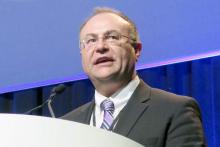SAN FRANCISCO – One biomarker appears down and out in the MAVERICC trial of first-line therapy for colorectal cancer, but another may yet deliver, according to findings reported at the Gastrointestinal Cancers Symposium.
A total of 376 patients with untreated metastatic colorectal cancer were enrolled in the phase II trial, which is comparing two combination regimens and exploring molecular strategies for predicting benefit from each.
The patients’ tumors were tested for expression of the excision repair cross-complementation group 1 (ERCC1) gene, a potential biomarker for chemoresistance to platinum compounds. And their plasma was tested for vascular endothelial growth factor A (VEGF-A), a potential biomarker for benefit from antiangiogenic and other therapy.
They were then randomized evenly to receive the oxaliplatin-containing modified FOLFOX6 regimen or the oxaliplatin-free FOLFIRI regimen, each combined with bevacizumab (Avastin), an antibody against VEGF that has antiangiogenic activity.
“FOLFIRI-bevacizumab and mFOLFOX-bevacizumab appear comparable in this exploratory study with respect to progression-free and overall survival,” reported first author Dr. Heinz-Josef Lenz, associate director for adult oncology and coleader of the gastrointestinal cancers program at the USC Norris Comprehensive Cancer Center in Los Angeles. “However, we saw a trend toward a benefit of FOLFIRI-bevacizumab over mFOLFOX-bevacizumab in this patient population and a particular difference in the left-sided tumors.”
At the same time, he cautioned that patients in the FOLFIRI arm got substantially more chemotherapy as counterparts in the mFOLFOX arm often stopped treatment because of oxaliplatin-related neurotoxicity.
Unexpectedly, patients having high tumor levels of ERCC1 did not fare significantly worse if given mFOLFOX6-bevacizumab than if given FOLFIRI-bevacizumab, with a difference of roughly a month in progression-free survival between them. But a caveat here was that only about a third of patients fell into the high ERCC1 category, whereas half have in previous trials, Dr. Lenz said at the symposium, sponsored by the American Society of Clinical Oncology, ASTRO, and the Society of Urologic Oncology.
Results regarding the predictive value of VEGF-A, alone and in combination with ERCC1, are expected shortly, according to Dr. Lenz. Additionally, “we have extensive molecular analyses ongoing, and we will present these at ASCO this year, so stay tuned. There are some very exciting, interesting data developing.”
Invited discussant Dr. Wells A. Messersmith, professor and codivision head, division of medical oncology, at the University of Colorado at Denver, Aurora, commented that the trial’s data will have to mature to obtain a more definitive picture of overall survival, differences by tumor location, and the predictive value of ERCC1.
“Should we be surprised to see that ERCC1 failed? From my standpoint, this joins a long list of failed predictive tests in cytotoxic chemotherapy,” he said. As opposed to RAS for predicting benefit from agents targeting the epidermal growth factor receptor pathway, and microsatellite instability for predicting benefit from immunotherapy, “the predictors for cytotoxics for the most part have failed. It’s really unclear why this is.”
“These agents work by damaging DNA. Perhaps that’s too primordial of a pathway, although certainly BRCA works,” Dr. Messersmith commented. “There’s a lot of redundancies and workarounds [in this pathway]. These pathways are also nonstatic and change in response to chemotherapy. Finally, there are hundreds if not thousands of variants in human populations.”
In the MAVERICC trial, patients in the FOLFIRI arm received three to six more cycles of their assigned chemotherapy and about three more cycles of bevacizumab than peers in the mFOLFOX6 arm, Dr. Lenz reported.
With a median follow-up of 18.5 months, the two regimens yielded similar median progression-free survival (10.1 vs. 12.6 months, P = .056) and overall survival (23.9 vs. 27.5 months, P = .086) in the entire trial population.
Among patients with high tumor ERCC1 expression, median progression-free survival was 9.9 months with mFOLFOX6-bevacizumab and 11.2 months with FOLFIRI-bevacizumab (P = .394). Among patients with low tumor ERCC1 expression, respective values were 11.0 and 12.7 months (P = .079).
Findings were essentially the same for overall survival. Among patients with high tumor ERCC1 expression, median overall survival was 22.6 months with mFOLFOX6-bevacizumab and 26.5 months with FOLFIRI-bevacizumab (P = .330). Among patients with low tumor ERCC1 expression, respective values were 25.5 and 27.9 months (P = .152).
“It seems that patients with low ERCC1 do better with both treatments overall, with FOLFIRI in progression-free survival and overall survival always on top, but not reaching statistical significance,” Dr. Lenz remarked.
In a prespecified analysis looking at the impact of tumor location, the group with left-sided tumors had better progression-free survival if they received FOLFIRI-bevacizumab instead of mFOLFOX-bevacizumab (13.8 vs. 10.2 months; hazard ratio, 0.71; P = .04). In contrast, there was no significant difference in the group with right-sided tumors.



